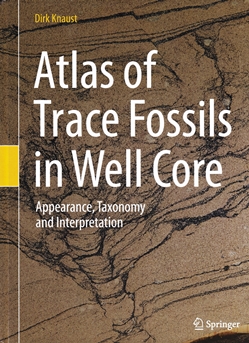 Your reviewer will reveal an embarrassing secret: despite logging cores for nearly 40 years, I have never felt assured in identifying trace fossils. I can pick out Skolithos and distinguish it from Chondrites and other key genera, and use them to diagnose environments and energy levels. But how about those other enigmatic markings, possibly of organic origin, but not falling into the half-dozen or so ichnogenera remembered from long-ago courses or well-thumbed manuals? Now, thanks to Dirk Knaust’s excellent textbook, I can face future ichno-questions with renewed confidence. I don’t think I shall be alone.
Your reviewer will reveal an embarrassing secret: despite logging cores for nearly 40 years, I have never felt assured in identifying trace fossils. I can pick out Skolithos and distinguish it from Chondrites and other key genera, and use them to diagnose environments and energy levels. But how about those other enigmatic markings, possibly of organic origin, but not falling into the half-dozen or so ichnogenera remembered from long-ago courses or well-thumbed manuals? Now, thanks to Dirk Knaust’s excellent textbook, I can face future ichno-questions with renewed confidence. I don’t think I shall be alone.
What makes this volume so attractive is the quality and variety of its photography. Each ichnogenus is figured in slabbed core with multiple images, with field photographs of ancient and modern environments, some including the creatures forming the traces. Bedding planes and vertical sections are shown, supported by sketches and other three-dimensional representations of the respective trace-fossil structures.
Marine forms dominate the atlas and there is little on freshwater or terrestrial trace fossils, although this reflects those most commonly found in core. The core photographs are mostly from the Mesozoic of the Norwegian continental shelf, so that carbonate environments have limited coverage, which will restrict the book’s usefulness within some basins.
Minor niggles: an atlas should be easily navigable, and this one isn’t. Some of the numerous illustrations are separate from the relevant text. Individual bibliographies for each section involve needless repetition. And the text diagram of ‘hierarchically arranged diagnostic criteria’ for identifying the ichnogenera described is valuable, but an ‘idiots’ guide’ conveying the same information in a series of thumbnail sketches, referring to page numbers of the detailed descriptions, would be of immense assistance. Some advanced scholarship could have been sacrificed for the sake of ease-of-use.
The book is not aimed at researchers, who will already have Elsevier’s 2012 Developments in Sedimentology volume, and will be awaiting the forthcoming Treatise on Invertebrate Paleontology on the topic, as well as using the wider literature. Other trace-fossil guides for non-specialists exist, but most are course manuals or oil-company in-house compilations, often unavailable to the general reader. An exception is the SEPM Short Course No. 15 on Ichnology by Ekdale, Bromley and Pemberton, still available digitally, which though now dated (1984) remains a valuable resource, especially for cash-strapped students. But it lacks the photography and recent advances of Knaust’s volume, which is likely to become the standard trace-fossil guide for postgraduates and professionals.
Review by Graham Blackbourn
ATLAS OF TRACE FOSSILS IN WELL CORE: APPEARANCE, TAXONOMY AND INTERPRETATION by DIRK KNAUST, 2017. Published by Springer Nature 214pp (hbk) ISBN: 978-3-319-49836-2 e-book ISBN: 978-3-319-49837-9 List Price: £74.50 e-book £58.99. W:
www.springer.com/gp/book/9783319498362.